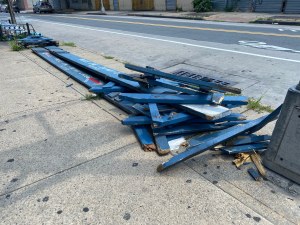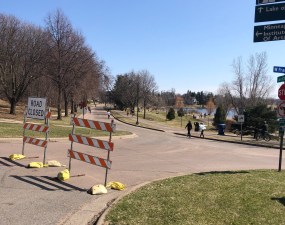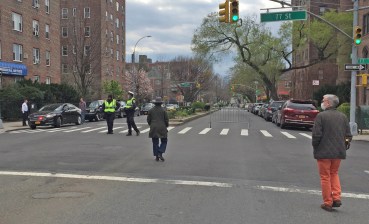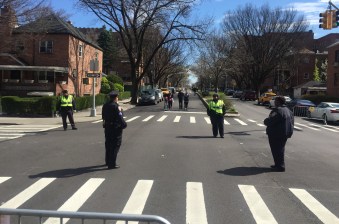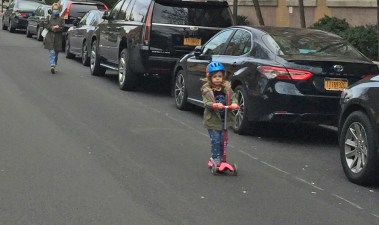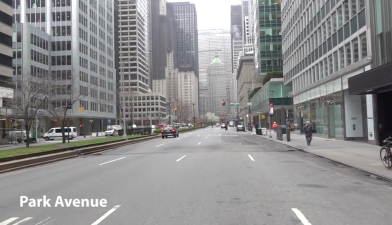ANALYSIS: Why De Blasio’s Open-Space Pilot Was Such a Failure (And Check Out What You Can Do With Cones!)
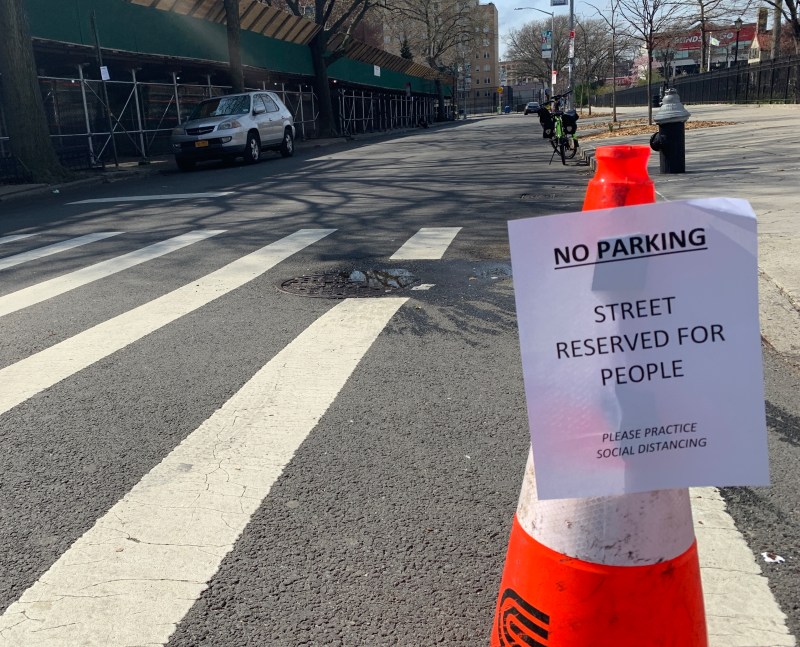
Mayor de Blasio’s minuscule open-streets pilot flamed out in just 11 days because he deferred to the NYPD, a majority suburbanite force that considers pedestrians as potential criminals who need to be policed — a marked departure from other cities that have created far more open space with little or official presence.
That’s the assessment of open space experts, former and current government officials and advocates who watched as de Blasio begrudgingly created a four-street, 1.5-mile pilot open space program under orders from Gov. Cuomo, then deployed so many cops to patrol the new public space that the project ended before it could be expanded.
“They way overthought things, and picked the most expensive possible staff to manage it,” said one former top city official. “You never see that many NYPD officers at street fairs, and yet they manage to close a mile or two of Broadway, Ninth Avenue or Sixth Ave. without a fuss so vendors can sell tube socks and funnel cakes.”

From the very start of the coronavirus crisis, de Blasio had said he could not ban cars from roadways without a large police presence. And when he finally created his four short stretches — on 34th Avenue in Jackson Heights, Park Avenue in Manhattan, Bushwick Avenue in Brooklyn and the Grand Concourse in The Bronx — they were patrolled by more than 80 police employees, according to witnesses and Streetsblog’s own count.
“We need more space for people and City Hall didn’t do it because NYPD is controlling the conversation,” said a different former city official. “That’s why we got what we got and that’s why it didn’t work.”
But it did not have to be that way.
At 80 officers for 1.5 miles, I can't overstate how over-policed NYCs #OpenStreets were. At that ratio, 18 miles in Minneapolis requires more police than are employed in their entire 800-person dept. Denver's 10 miles would require 35% of its 1500+ force! https://t.co/WZ8v2QHs0n
— Mike Lydon (@MikeLydon) April 7, 2020
Mike Lydon, an urban planner based in Brooklyn, has been regularly updating a Google document that includes all the open-space projects around the globe. The document makes it clear that not only were de Blasio’s ambitions tiny, but his approach was misguided.
Portland, Ore., Denver, the Twin Cities (both of them!), Philadelphia, Calgary, Winnepeg, Duluth, Cleveland, Vancouver (the Canadian one) and Bogota, Colombia all created more total miles of car-free streets (and far more per-capita) than New York, where car traffic is down by close to 80 percent.
“I can’t overstate how over-policed NYC’s open streets were,” Lydon tweeted. If Minneapolis had deployed cops at the same rate as New York City, its 18 miles of open streets would have required the city’s entire 800-person police department, Lydon added.
“Denver’s 10 miles would require 35 percent of its 1,500+ force!” he added.
The main problem is that the NYPD, a law enforcement agency whose employees mostly live in the suburbs, oversees how city streets are managed rather than the Department of Transportation (neither agency would comment for this story). The virus reveals anew what many advocates have long said: The agency that designs and builds the roads should be in charge of enforcing the rules of said roads, while the police department should focus on its main mission: preventing crime and apprehending suspected criminals.
Council Speaker Corey Johnson suggested on Monday that things must change.
“We can do something a lot bigger than [the four-street plan] while not needing a lot of personnel,” Johnson said. “We want to be strategic, we want to be smart [and] look at wide swaths and stretches [of roadways to open up].”
Even if the police are allowed to maintain their oversight of major events — which often involve multiple agencies — smaller projects like “Summer Streets” and the mayor’s pilot program need to be rethought.
“Managing public space is not the same as crowd control at a mass event,” said Jon Orcutt, a former DOT official. “This would be a good time to establish the distinction in official city practice.”
Or, as the other former city official told Streetsblog, “PD seems to be hung up on this idea that each closed street needs two or three cops. We all know that’s not true. Anyone in a yellow vest can manage traffic.”
Ah, yes, the yellow vest. Since the demise of the mayor’s open streets plan, many community leaders and block association officials have offered to show Mayor de Blasio and Police Commissioner Dermot Shea just how easy open-streets could be.
Christine Berthet of the legendary Chelsea-Hells Kitchen group CHEKPEDS asked the city to ban cars on 16 crosstown residential streets between 14th and 56th streets — which would have comprised 11.4 miles of open space — or 10 times what the mayor was able to accomplish for 11 days.
“By the way, the budget for four cones, tape and a ‘5 MPH’ sign is $100 per block,” she said. “Every block association should be able to swing this. Maybe Transportation Alternatives could educate them on how to do it.”
The city itself knows how to do this. Last year, Streetopia UWS held an all-day car-free party on Broadway between 73rd and 78th streets with no cops at all. No one was hurt. Everyone had a great time.
“We had zero cops,” said organizer Lisa Orman. “In fact, the cops forgot to close the street and later came and placed some cones out for us. But we were out there all day with no issues. Their underlying premise that we need cops to police the streets is so off. Traffic is what makes the streets dangerous. If anything, we would need fewer cops if we opened more streets to pedestrians.”
Fewer or no cops at all, as street safety activist Doug Gordon has showed this week. Since Sunday, the Park Slope resident (and future Bike Mayor?) has blocked off Fourth Street west of Fifth Avenue merely by moving some existing barriers that are left on the side of the road for the weekly farmer’s market. And it’s working.

On the metal barriers, Gordon posted signs, “Street open for social distancing” and “No parking: Street reserved for people” — and said drivers have obliged, and other residents have strolled or taught their kids how to ride bikes with nary a cop to make sure everyone is following the COVID-era guidelines.”
“Doing something like this is never as hard as people with institutional rot in their brains think it is,” said Gordon.

“They need to think creatively. They can only think of the existing tools they have,” he added, referring to the mayor’s apparent belief that public space need cops or that street safety changes need lengthy public hearings at community boards.
If indeed city personnel were truly seen as needed, the workers certainly did not need to be cops, said one of the ex-city officials we cited above.
“There are probably thousands of other agency personnel who are unable to do jobs because their offices are closed, working for agencies like DOE — what are physical ed. teachers and coaches doing now? — DOT, Cultural Affairs, etc.” the former official said. “Many of them could have been pressed into service.
“In short,” the former top department official said, “the mayor had no interest in dong anything real, and he created something destined to fail.”
LOOK what they are doing in Denver! This video from @NoSquish has some amazing overheads and footage of the miles of streets Denver has made car-free! Particularly 3:16 with great narration!@StreetsblogNYC @NYCSpeakerCoJo @StreetsblogNYC @BrooklynSpoke https://t.co/jyMJaPlBb9
— Streetfilms (Now 1,100 films strong!) (@Streetfilms) April 7, 2020
